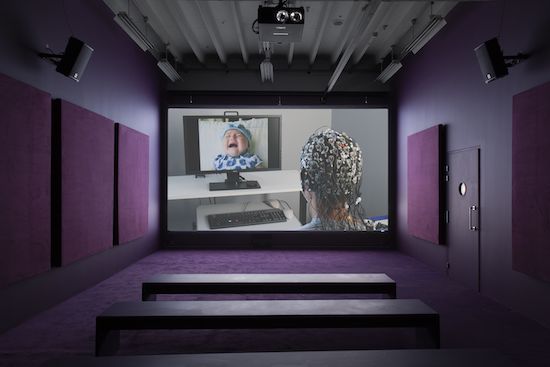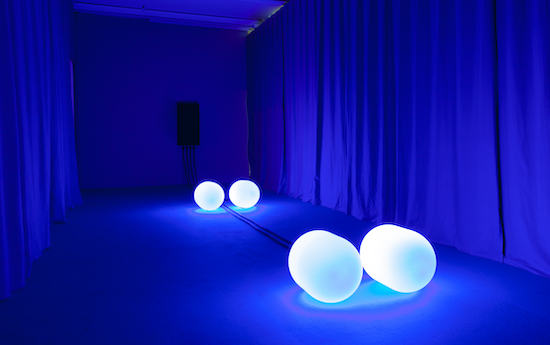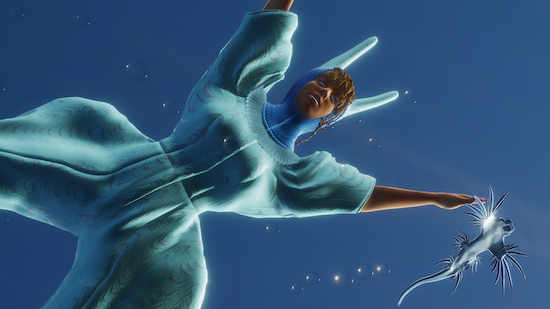Hannah Black & Juliana Huxtable & And Or Forever, Penumbra, 2021. Courtesy of the artists and Centre d’Art Contemporain Genève
The lights throb, somehow both inviting me in and warning me off. Like an anti-lighthouse, the lights pull me closer, and across the threshold into the industrial darkness of the Centre d’Art Contemporain’s galleries. There is no other light apart from the throb, and to enter the curtain-clad space’s slow strobe, I have to read the room in a new way, stepping into the shadows, allowing my eyes to adapt, and then trusting myself to head deeper.
Openings in the curtains reveal doors with porthole windows, a changing light from behind the glass pulls me closer. Peeking through, I see pews. Unexpected. I pass into this new space, take my place on the wooden seat, and find myself in a courtroom where on the screen in front of me a frenetically-paced legal argument is ongoing. Perhaps I am the jury, I wonder, as a CGI penguin waddles across the screen.
The two protagonists of the piece, as both living artists and digitised avatars, are Hannah Black and Juliana Huxtable. They are verbally sparring – as prosecution and defence – over crimes including “being disgusting” and “the murder of everything” which all animals are here accused of, the penguin included. “We have taxidermied our capacity for life”, the digital Huxtable says. An aardvark stands in the dock, seemingly breaking the fourth wall by looking straight towards me and the ‘real world’. Maybe, I wonder, I am not just the jury but also in the dock.
It’s a bracing welcome to the twenty-first edition of the Biennale de l’Image en Mouvement, a project which began in 1985, ever-since tracking the trends and shifting focus of moving image artworks from Bill Viola to Chantal Akerman, Harun Farocki to Lauri Anderson. Even the phrase “the moving image” can be traced to Geneva, swapping names, from International Video Week to its current moniker, back in 1999. In the words of the Centre’s director and co-curator of BIM21, Andrea Bellini, “The concept of ‘video art’, both from a technological and linguistic point of view, seemed to us – already then – to be completely outdated.” The CGI bird which has just landed in the projected courtroom attests to the exponential drive of new technology into art.

Courtesy of Will Benedict and Steffen Jørgensen for BIM ’21
I step out and into a neighbouring room, popping on 3D glasses to pull Camille Henrot’s film Saturday into the space between me and its surface projection. Made – presciently perhaps – before the pandemic, Henrot explores hope, and how it supports social and individual survival through global crises. Twenty-four hour news tickertapes of travesty (“Red River floods … Emergency COBRA cabinet meeting on foot and mouth disease … Oil tanker train collision … Earthquake triggered tsunami …”) scroll between images of baptisms, medical procedures (and medicalised beauty procedures), and other manifestations of hope in a cruel world. A recurring motif of televangelists with phone-bankers praying for anyone who rings, set against mediated disasters, remind me of the industry’s reliance upon despair and hope.
For each edition of BIM, Bellini, who has overseen the Centre since 2014, invites a new co-curator to “push the project towards different and unexpected directions”. Likening his role to an orchestra conductor, his collaborator this year is DIS, the New York collective which pull at all strings cultural, fashion, advertising, and political. Their approach and network saturate the Biennial, injecting a strong sense of the New York art scene into the quiet Swiss city. Having started off in 2010 with a magazine, DIS also set up an alternative stock image agency, then a concept store for art, and now (through www.dis.art) a streaming platform for “edutainment”, pushing at the boundaries of conceptual moving image work with a social, political, and activist voice.

Camille Henrot, Saturday, 2017. Courtesy of the artist & kamel mennour (Paris/London); Galerie König (Berlin/London/Seoul); Metro Pictures (New York). Exhibition view of the Biennale de l’Image en Mouvement 2021 at Centre d’Art Contemporain Genève, 2021. Photo : Quentin Touya © Centre d’Art contemporain Genève.
It’s with this latest DIS-iteration that they were invited to not only co-curate, but also contribute through their first feature film, Everything But The World, a collectively produced series of short vignettes: a lawyer delivers a semi-staged lecture on the nature of home and homelessness; a tour group of witchery history around a castle; and the hilarious wormhole experience of White Castle drive-through operator Mark, who instead of processing food orders takes the customer on a quick-fire lecture on the nature of speed, time, and endlessness. “So, while this next batch of burgers are cooking in the steamer, I want to give my hyperbolic metaphor of the notion of ETERNITY.” … “OK, um. Can I also… add a strawberry?” … “Plus, I have your food in my hand, so I am more or less the God of White Castle right now, and who gets to argue with God?”
As I observe this existential eatery, ceiling fans chill from above and an electric blanket warms below, perhaps in its own way talking to the anthropogenic situation present across so many of the works. The set-design approach also speaks to the experiential and architectural nature of BIM21. Each artist has their own room, those porthole windows teasing glimpses of work within which can’t really be anticipated until entering. Each space is unique. This is not a moving image exhibition of monitors on plinths and wall projections, but an enveloping experience which, in the words of Bellini, seeks to “create a place that is physical and mental at the same time”.

Simon Fujiwara, Once Upon a Who?, 2021. Courtesy de l’artiste et du Centre d’Art Contemporain Genève
On the floor above I find myself in an increasingly dark corridor, softly lit by more of those pulsating light sculptures behind me. They are by Grau, which is Timon and Melchior Grau who studied under German artist Hito Steyerl and make work floating between the technical and human. Here, in their “timebased performance”, the lights not only provide (just) enough illumination to navigate, but also punctuate the other works around the exhibition.
Off the darkening corridor are more unexpected realms. Cosy beanbags invite me to listen to a Mandy Harris Williams reworking of Edward Said’s Reith Lecture on representation and knowledge, transmogrified from BBC Radio 4’s format into a 1990s MTV aesthetic. Entering Sabrina Röthlisberger Belkacem’s room I see figures in the shadows, seated and standing as they watch unnerving music videos filmed amongst ruined architectures as nature reclaims them – only to slowly realise they are in fact static representations of the semi-human beings within the films.
In the next room I recline into a shabby chic nineteenth-century sofa to enjoy Emily Allan and Leah Hennessey’s proudly-lo-fi, gender-swapped telling of Lord Byron and Percy Bysshe Shelley’s 1816 meeting at Villa Diodati, at the edge of Lake Geneva. Imagining the poets as drugged-up, sexed-up “illuminati detectives” for a TV pilot episode, I think it would actually make better programming than most period dramas we consume.

Grau, Fire, 2021, Series of dynamic light sculptures, Glass, aluminum and LED-technology.Exhibition view of the Biennale de l’Image en Mouvement 2021 at Centre d’Art Contemporain Genève, 2021. Photo : Quentin Touya © Centre d’Art contemporain Genève.
Leaving their villa, bright lights and jingling sounds pull me from the corridor, around a corner, and into a space of contrast. From oppressive darkness I emerge into Simon Fujiwara’s softly-furnished blue and pink chamber. His catchy tune and stop-frame paper-cutout story follows Who, a bear on a journey of self-identity in a judging, scary world. He reads Grindr on his smartphone, rides his flashy new car, and searches for ancestors in ancient Egypt and the British ‘Whoseum’. It’s a delightful respite from some of the more aggressively serious or lecture-like works on show. But as I watch the song loop round and round, sitting in my plush pink seat, the cartoon becomes more sinister, and my sadness for the bear more real. “I am Who, I am.” I wonder.
It gets more unnerving after. Escaping Fujiwara’s kitsch, I open another portholed door and find myself momentarily inside an image, a projection flooding the wall and door I just passed through. The Restaurant, Season 2 continues a project by Will Benedict and Steffen Jørgensen set within a rainforest skyscraper filled only with restaurants. This second series (we see both of the first two episodes at BIM) follows the owner of the imaginary Café What? serving lone customers within an interrogation room – only after cross-examination. We cut from the intense servery to a radio studio somewhere out in the jungle, observing animals and absurd creatures discussing the topic of the day on their show Animal Fart = MC². “When was the first fat?” starts a pseudo-science lesson.
Fluidity and confusion between animal and digital, human and mechanical, expected and irrational, is a recurring motif as I meander through these absurdist spaces. It is in such moments, drifting between the everyday and the uncanny, when the works most successfully force us to question our individual or collective selves, as well as our relationships to wider ecosystems – whether they be information, nature, or identity.
When I leave, the works follow. Figures I met along the way haunt me, in both pleasant and anxious ways. I worry about that penguin and if they were found guilty of simply being a penguin. I feel for Who the bear and his search to find himself. I wonder if those drive-through customers at DIS’s White Castle ever got their chicken rings and waffles, or if they are still waiting, eternally waiting.
The moving image may be the perfect vehicle for taking us on that oblique journey to the uncanny and unnerving, helping us question or consider in ways parallel to and parting from our norm. But after two years of Zooming and Facetiming, do screen-based works still have an aura and allure? Bellini suggests that 133 years after Eadweard Muybridge’s first moving-image, it’s going to keep our gaze but in evermore experimental ways. “It seems clear to me that we will have to get used to experiencing art in both real space and virtual space,” he tells me. “I believe that technology is destined to add something fruitful to our expressive possibilities, not to take something away.”
After leaving BIM, at a train station elsewhere in the city, I see a glitch in normality which plays with that duality. Green lights leak through the porous Jean Nouvel architecture of the Gare Cornavin, summoning me. And deep in its belly, a vast, horizontal, otherworldly green fans out to fill the hall. A discordant noise like a comedown Brian Eno saturates the soundscape. A digital screen tells the work is by Riccardo Benassi, a human-algorithm collaboration designed to put a phrase a day into the subterranean space. Day one’s reading states: “In the world there is a single yawn that continues by contagion to spread in search of another yawn to fall in love with”. Some Genevans walk by. Some see it, nonplussed. Others stop or take the text in as they pass by, taking its oblique meaning with them into their own worlds.
Biennale de l’Image en Mouvement 2021, A Goodbye Letter, A Love Call, A Wake-Up Song, runs until 30 January 2022 at The Centre d’Art Contemporain, Geneva, Switzerland


